What You Didn't Know About Celery
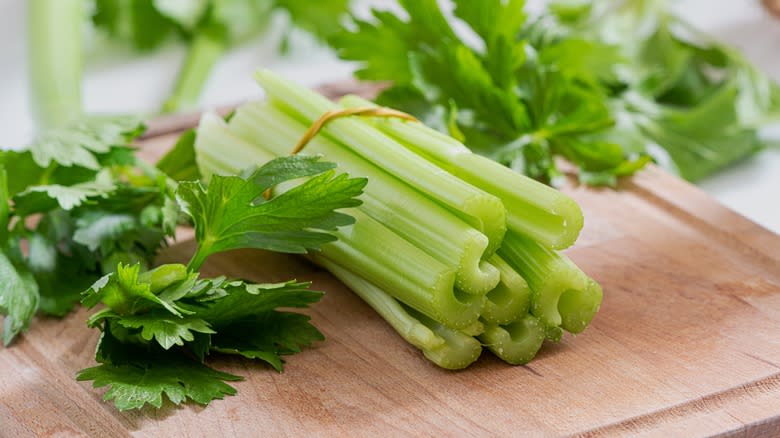
With so many vibrant veggies to choose from at the grocery store, celery might seem like a slightly underwhelming choice. It's often used as the base of soups and stews, or as a vehicle for creamy dips, rather than the main event of a meal. But we think this veggie deserves more recognition -- celery is far more versatile than you might think, lending itself to a wide range of cooking techniques. Rich in vitamins and minerals, it also boasts an impressive array of nutritional benefits, as well as serving as a natural remedy for a range of ailments.
In addition to useful facts you may not know, you might also believe some myths about this veggie, like its reputation as a so-called "negative calorie" food. In this article, we're exploring the world of celery to bring you the low-down on this green wonder. You'll learn how celery can be used, stored, and even grown, as well as exploring some fascinating facts about its history. It's time to give these crunchy stalks a chance and embrace everything that this nutritious veggie has to offer!
Read more: Mistakes You're Making With Your Corn On The Cob
Celery Is Packed With Nutrients
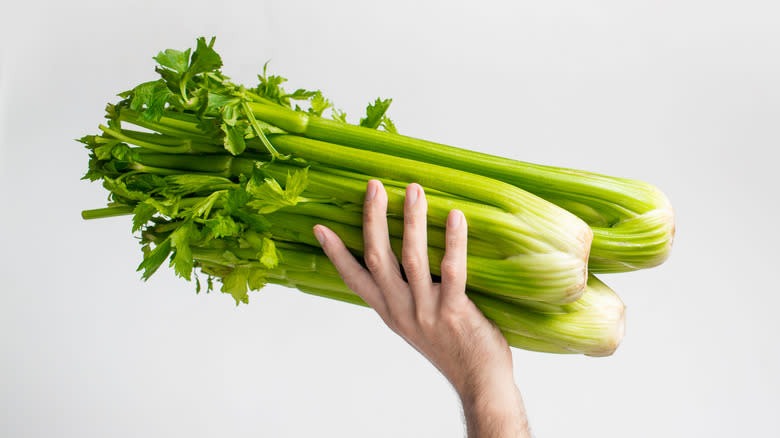
Eating this crisp green veggie is certainly a great way to get your nutrients. One of celery's standout features is its high water content, so snacking on it is an excellent way to stay hydrated, especially on hot summer days. But don't think that all that water means celery is nutritionally weak -- it's rich in vitamins A, K, and C, as well as potassium and folate. These nutrients offer a slew of benefits, from boosting eye and nervous system health to their antioxidant properties. You'll also get a good dose of fiber when you enjoy this veggie, so it's great way to support healthy digestion.
Additionally, celery is a good source of phytonutrients, which have been linked to potential anti-inflammatory benefits. Its plethora of antioxidant compounds can help to protect your cells from damage caused by free radicals, and may even reduce your risk of developing chronic diseases like diabetes. Plus, celery is a food with a low glycemic index, which means it will help to keep your blood sugar stable, rather than causing any significant spikes. This veggie definitely earns its place as a staple in a healthy diet.
Celery Consists Of 95% Water
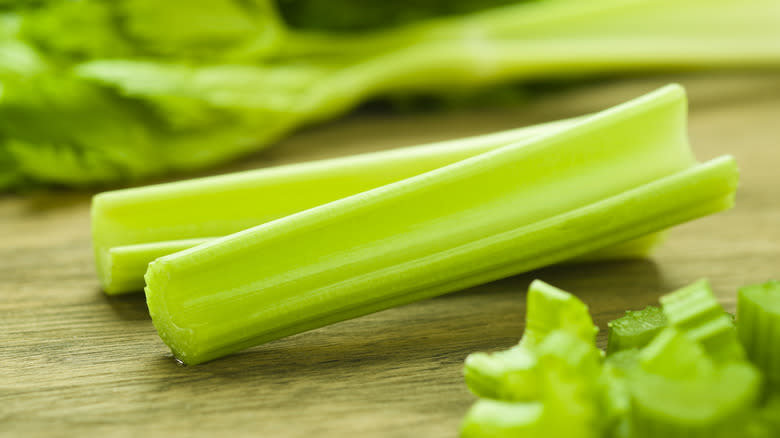
Celery's reputation as a hydrating snack is well-deserved. It's actually composed of an impressive 95% water, which gives it that signature juicy crunch and makes it super refreshing. One cup of this veggie contains 115 grams of water, or about half of a cup.
Celery's wonderful crisp texture and subtle flavor makes it a great bite on its own, but to make it a little more interesting, enjoy a platter of celery sticks with other hydrating veggies and your favorite dip. Cucumbers, tomatoes, zucchinis, and lettuce are other fruits and veggies that can help you stay hydrated. Eating celery and other hydrating produce after a workout is an excellent choice, as their nutrients help to replenish both water and electrolytes that are lost during exercise.
Of course, drinking water is the primary way we should be getting our hydration, so don't go replacing your water bottle with a bunch of celery. Still, according to UT Southwestern Medical Center, you should aim for about 20% your daily water intake to come from food, so a few stalks can be a great contribution.
Celery Does Not Contain 'Negative Calories'

You may have heard the term "negative calories" tossed around in reference to certain foods like celery. The idea is that these foods expend more calories to digest than you gain by eating them, resulting in a net calorie loss. However, if you think this sounds too good to be true, that's because it is.
Celery is certainly low in calories, but munching on a stalk won't magically burn off more calories than you're putting into your body. In an interview with the BBC, Tim Garvey, the chair of nutrition sciences at University of Alabama at Birmingham, explains that negative calorie foods simply do not exist. While there are 10 calories in one stick of celery, your body only uses about 2 calories to digest it -- a tiny net amount, to be sure, but not in the negative.
Despite this, celery is definitely still worth incorporating into your diet for the benefits we've already covered, and its plentiful fiber can help you feel more full and satisfied while ingesting fewer calories. Just make sure not to overdo it; celery definitely doesn't supply the carbs, fats, and proteins you need on a daily basis for adequate nourishment.
Celery May Help To Manage Symptoms Of Some Diseases
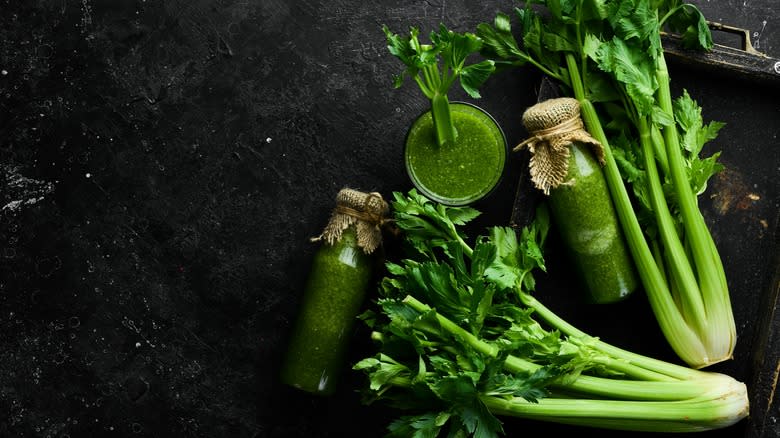
Celery is certainly nutritious, but does it also have healing properties? Well, there are a range of claims that it can help with certain ailments, and some of these do have the backing of scientific research. According to Vinmec, this veggie contains about 25 anti-inflammatory compounds. Chronic inflammation is associated with a range of autoimmune, cardiovascular, and gastrointestinal diseases, so reducing inflammation through one's diet can be an important way to manage symptoms for those affected by such conditions. Furthermore, this veggie is often used as a natural remedy to treat digestive issues.
Research suggests that phytonutrients and polysaccharides found in celery may improve the health of digestive mucosa and protect the body from developing gastric ulcers. There is also evidence that consuming celery can lower blood pressure. This is due to its plentiful phytochemicals, specifically a type called phthalides. Research has shown that phthalides have the ability to relax the surfaces of our artery walls, so blood can flow with more ease.
Cleveland Clinic's Luke Laffin, MD, from the organization's Department of Cardiovascular Medicine, suggests eating roughly four stalks of celery per day (that's about one cup when chopped). Eating celery whole, rather than juicing it or blending it into a smoothie, allows you to benefit most from its blood pressure-regulating fiber.
Organic Is Best When It Comes To Celery
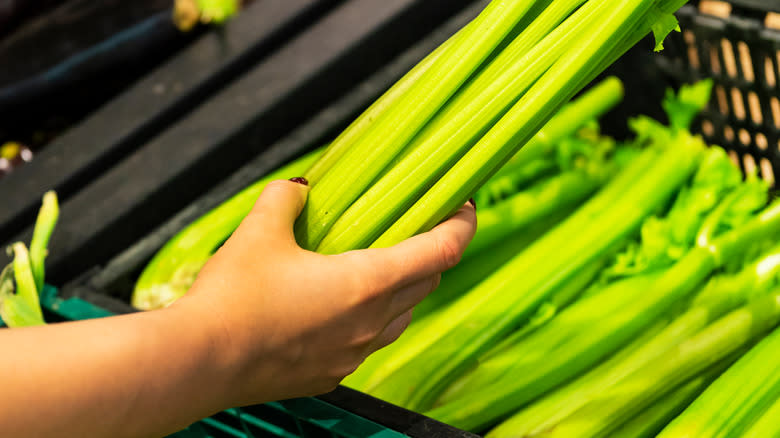
One important decision to make when selecting celery at the grocery store is whether you should spring for an organic bunch, or a standard variety. Under the definition of organic foods, organic celery must be grown without the use of pesticides and fertilizers. Standard produce might contain residue from these potentially harmful manmade chemicals -- and it turns out that celery might be "dirtier" than most.
Each year, the Environmental Working Group tests a range of commercially-grown, non-organic fruits and vegetables for pesticide residue levels, and reveals which pieces of produce contain the most chemicals. In 2024, celery was the 16th most contaminated out of the 46 produce items tested. However, in 2022, it made the EWG's "Dirty Dozen" list of top offenders, taking spot number 11.
With celery sitting amongst the top pesticide-containing fruits and veggies, opting for organic will guarantee that you consume less chemicals. Though the organic stuff might come with a slightly higher price tag, it's important to note that exposure to pesticides has been linked to various diseases, such as Parkinson's, Alzheimer's, and some types of cancer. Concerned consumers should opt for organic celery whenever possible.
You Can Eat The Leaves
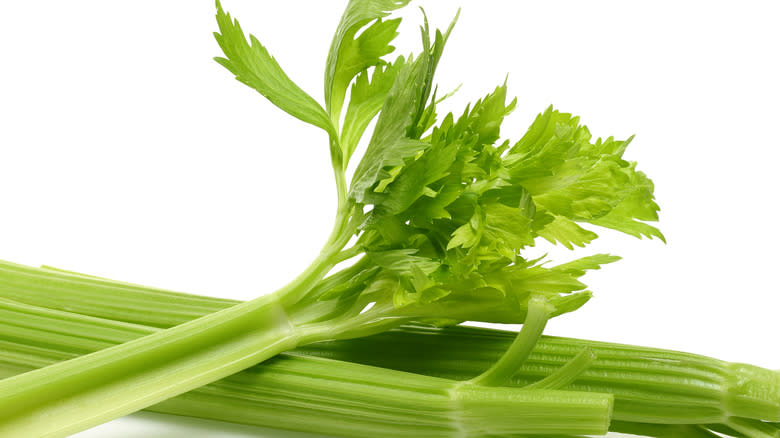
How many times have you chopped up celery stalks and thrown the leafy tops right in the trash? That seemingly-insignificant part of the head is actually entirely edible, and there are many reasons to save celery leaves, the biggest one being their plentiful flavor and nutrients. They have a slightly stronger flavor than the stalks, with a hint of bitterness and a taste similar to that of fresh parsley.
There are so many ways to use these leafy greens. Firstly, they make a great replacement for fresh herbs. Chop them up and use them as a flavorful garnish on your main dishes, or stir them directly into condiments and seasoning mixes. Celery leaves also make a wonderfully comforting soup. Combine them with onions, garlic, potatoes, vegetable broth, and a dash of heavy cream for a wholesome and delicious broth.
Another amazing way to use up leftover celery leaves is by incorporating them into homemade pesto. Simply use the leaves in place of basil for a unique twist on this classic Italian sauce. You can even use these flavor-rich beauties to make your own celery salt. The leaves must first be dried out in the oven or a skillet. Then, simply crumble them into small pieces and combine them with some flaky sea salt. This super versatile seasoning is perfect for adding a fresh green flavor to salads, fries, pizza, and even popcorn.
There's A Town Named After Celery
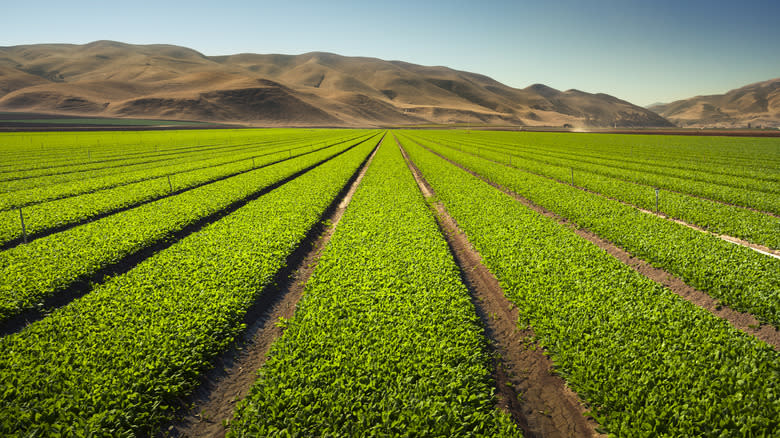
Have you ever taken a trip to Celeryville? We're not talking about just eating a lot of celery -- this is the name of a town located in the southwest of Ohio in the United States. Naturally, it has a history rooted in the cultivation and production of this humble veggie. Founded in 1896 by Dutch immigrants, who found a way to repurpose the marshy land in the area for farming, Celeryville soon became a huge hub for celery growth.
This is thanks to the area's incredibly fertile soil.The same marshy "muck" that can make areas of land difficult to thrive on proved to be the perfect environment for growing the veggie. The muddy ground is said to be so rich in nutrients that you can light it with a match during the drier months. As the celery industry flourished, Celeryville grew into a bustling agricultural community, with fields of celery stretching as far as the eye could see.
Today, Celeryville's methods of agriculture have evolved and modernized, but the town's proud heritage is still evident in its name and local way of life. Some major farms in the area, such as Wiers Farm Inc., are still run by the descendants of the Dutch settlers who founded the town. Wiers Farm also happens to produce a whopping 180 acres of celery per year.
Celery Is More Versatile In The Kitchen Than You Think
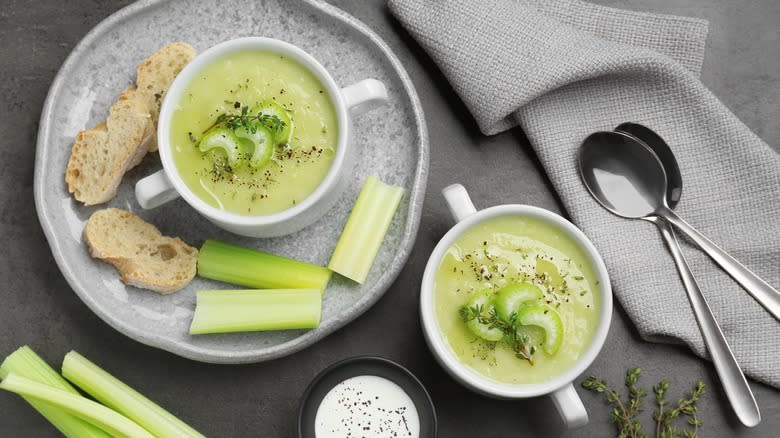
Celery is a delicious pairing for dips like peanut butter, hummus, dill onion dip, or even hot sauce, but there's more to this vegetable than snacking on it raw or sauteeing it for a soup. The stalks can shine as a unique addition to a range of savory mains and sides. Celery gratin is a delicious side dish that combines a whole head of celery with rich staples like butter, flour, milk, cream, and/or cheese. Top the mixture with bread crumbs and bake until wonderfully bubbly and brown on top.
Celery is also delicious when sauteed or roasted by itself. Or, try braising the stalks with some onion, pancetta, and tomato for a hearty and flavor-packed light lunch or side. Getting into green juices and smoothies, or just want a nutritional boost without adding a distracting flavor to your go-to beverages? Blend some celery right in there and enjoy its subtle green notes and a boost of hydration.
Of course, some applications for celery are classic for a reason. Its subtle sweetness and aromatic taste make it perfect for adding an extra layer of flavor to stews and casseroles. It's also fantastic at adding texture and freshness to salads, sandwiches, and wraps with its signature satisfying crunch. Try all these ways to enjoy it and you're sure to be impressed.
Wrapping Celery In Foil Can Keep It Fresh
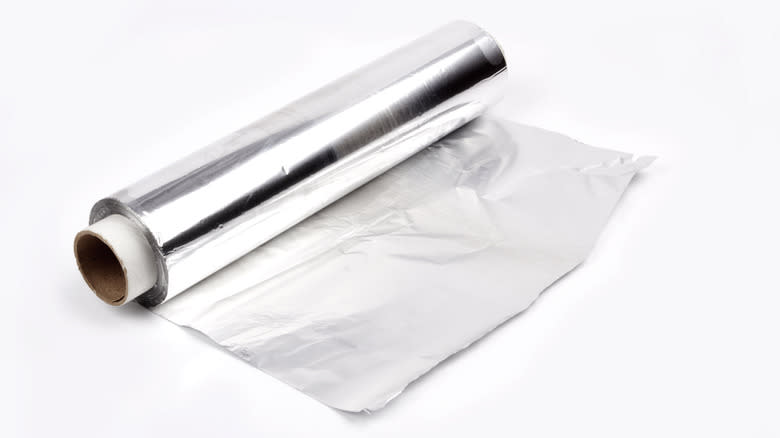
A limp stick of celery is a waste of a perfectly good veggie, so storing it correctly is a must to preserve that crunch for as long as possible. Thankfully, there's a handy trick that can help to extend the shelf life of this veggie.
Loosely wrapping celery in foil can help to protect it from excessive ethylene, a gas produced by certain fruits and vegetables as they ripen (even after they've been picked). Exposure to this gas can speed up the deterioration of many pieces of produce, including celery, which is both an ethylene producer and also sensitive to it. Wrap your celery in plastic wrap, and the gas will be trapped around the stalks, causing faster wilting.
Meanwhile, a loose wrapping in foil allows ethylene to escape while locking in the celery's moisture. That means fresher, crisper celery for longer. It's best to wrap a whole head of celery in a sheet of aluminum foil, as cut veggies pretty much always spoil faster than whole ones. Make your foil loose enough for ethylene to escape, but not so loose that the veggie dries out. Store the celery in the crisper drawer of your refrigerator, where it should stay good for up to four weeks, depending on its freshness when you bought it.
Celery Is A More Common Allergen Than You'd Think
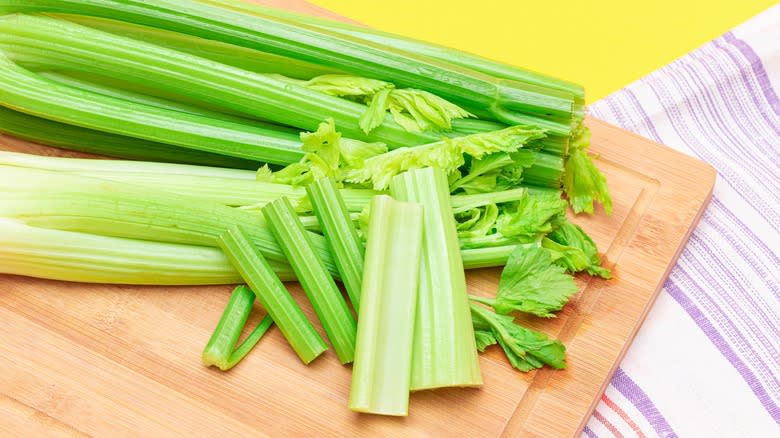
Celery hardly seems like an allergenic hazard on the same level as peanuts or shellfish, but sensitivity to this veggie is more common than most people realize. According to Thermo Fisher Scientific, the percentage of the general population that was sensitive to celery in 2014 was 6.3%, up from 3.5% in 2010. It's possible that the rate has only increased since then, and statistics become more alarming depending on which region of the world you examine. In Switzerland, 40% of patients with food allergies happened to be sensitive to celery, according to the same data from 2014.
Symptoms of celery consumption in sensitive individuals may include skin reactions such as itching or hives, respiratory symptoms like sneezing or wheezing, gastrointestinal issues such as nausea or abdominal pain, and in severe cases, anaphylaxis — a life-threatening reaction that requires immediate medical treatment. Sensitivity to celery is also linked to cross-reactivity with pollen. Those with allergies to certain pollens, such as birch, may also experience reactions to foods like celery. This is due to similarities in protein structures between the two.
It doesn't help that celery and celery-derived products (like celery salt) are actually hidden in far more foods than you might guess, from broths and gravies to sauces, spices mixes and juices. Sensitive individuals have to be extremely diligent about learning what celery byproducts they may react to and parsing them out on nutritional labels.
Humans Have Been Eating Celery For Over 3,000 Years
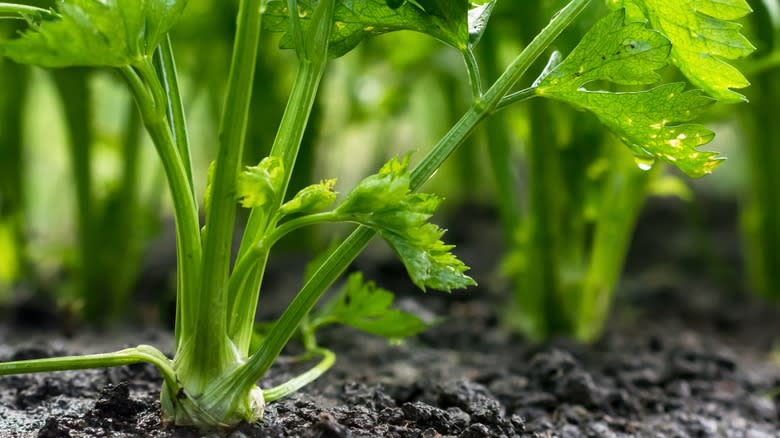
Celery's journey from a wild plant to a staple vegetable spans thousands of years, with evidence of its consumption dating back to ancient times. Historians believe that humans first consumed celery over 3,000 years ago, when it was valued mainly for its medicinal benefits. The ancient Egyptians used celery to treat a variety of ailments, from burns to colds to rheumatism. They also fashioned decorative garlands out of celery, which were even discovered in the tomb of Tutankhamun.
Historical records also indicate that the ancient Greeks used celery to make wreaths, which were presented to the athletes upon winning competitions. It wasn't until the 1600s that celery started to be enjoyed simply as a food and not a medicinal remedy. It became popular in France and Italy, where it was often eaten raw alongside a simple dressing. Over time, celery was selectively bred and cultivated into the most common variety we know today, with long, crisp stalks and a mild flavor. Earlier breeds of the plant had a much stronger taste, which some cooks across Europe and America chose to remove by blanching the veggie.
Celery Can Be Difficult To Grow

Celery is grown all around the world, but this seemingly simple crop can be quite picky. The plants have rather exacting requirements in order to thrive, and one of the biggest challenges is ensuring consistent moisture throughout the crop's long growth cycle. Celery requires plenty of water, yet it can be sensitive to waterlogged soil, which increases the risk of root rot. Farmers must strike a delicate balance for success.
Additionally, celery is a heavy feeder, meaning it requires fertile soil that is rich in organic matter, as well as frequent fertilization. Celery also prefers cool temperatures for optimal growth, so it thrives in climates with mild summers and cool winters. This is why it's become a popular crop in temperate regions.
As mentioned before, celery has a long growing season, which can last up to 140 days from planting to harvest. Growers need to ensure they can provide consistent care throughout the entire growing period to achieve the best results. Despite these challenges, the rewards of growing celery yourself can be well worth the effort. With carefully-planned prep of the ground, plus adequate watering and feeding, a wonderful harvest from your own garden is within reach. The process usually involves sowing the seeds in pots indoors, before transplanting them outside in organized rows.
The World's Tallest Celery Plant Reached A Stunning Height
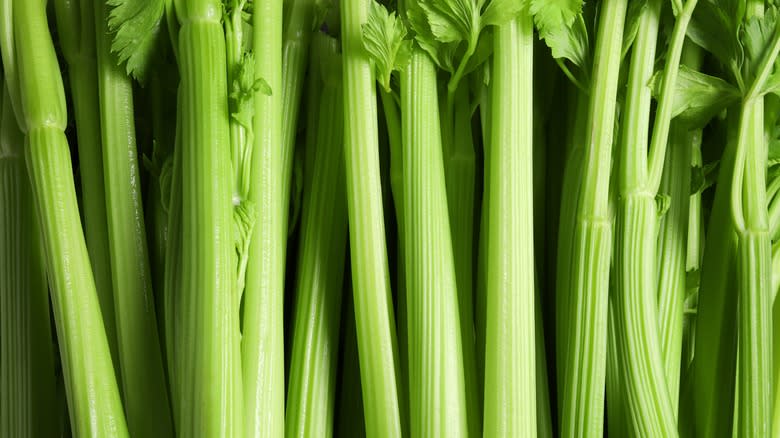
You might think you've hit the jackpot when you find extra-long stalks of celery at the farmer's market, but do you know just how tall this veggie can grow? One remarkable celery plant broke records for its towering height, reaching a whopping 2.74 meters tall (that's almost 9 feet!). This astonishing feat earned it the Guinness World Record for the world's tallest ever celery plant.
The colossal plant was grown in 1998 by Joan Priednieks from Somerset, United Kingdom. Priednieks reportedly bought the plants at a local school fete, and couldn't possibly have anticipated the massive heights it would reach. Sadly, the humungous celery was not edible due to its tough texture.
An equally impressive feat was achieved by Gary Heeks from Malvern, U.K., who grew the world's heaviest celery on record in 2018. He entered this super-sized beauty into the CANNA UK National Giant Vegetables Championship, where it took the top spot with an astonishing weight of 42 kilograms, or 92 pounds and nine ounces. The gargantuan celery required careful lifting onto a trailer by three men in order to transport it! While perhaps not excellent for eating, both of these behemoths prove that this mighty veggie really can surprise you.
Read the original article on Mashed


